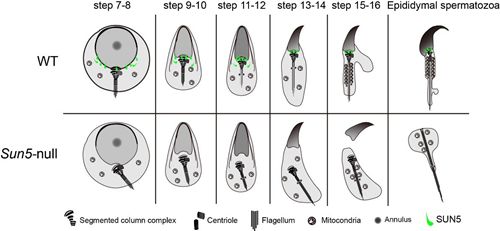Spermatozoa are the essential carriers of the paternal genetic materials to achieve sexual reproduction, so their morphology, motility and integrity are critical to male fertility. Teratozoospermia is resulted from the failures in morphogenesis of sperms, and substantially lead to male infertility. The acephalic spermatozoa syndrome is considered as the most severe subtype of teratozoospermia, since the sperms contain no nucleus in the head and are unable to fertilize the oocytes. The syndrome has been documented for decades and troubles patients till today, but little is known about its etiology.
Recently, the Protein Modification and Gametogenesis group led by Dr. Wei Li constructed the Sun5 knockout mice using CRISP/Cas9 system, and they found that the male Sun5-null mice were infertile due to the malformed spermatozoa. All the Sun5-null spermatozoa have globular heads with low motility, which is quite similar to globozoospermia. But further investigations reveal that there are no nuclei inside the “globular heads”, they are fulfilled with misarranged mitochondria and undetached cytosol, they are actually acephalic (decapitated) sperms. So, the Sun5-null mice are fine animal models of human acephalic spermatozoa syndrome. Using this model, they found that the key element coupling sperm head and tail - the sperm head to tail coupling apparatus (HTCA) could be finely assembled without SUN5, but it is not firmly attached to the sperm head. During the elongation of spermatids, the HTCA together with the flagellum are detached from the sperm head, thus yielding headless sperm tails as observed. Furthermore, they found SUN5 was localized to the connecting piece between sperm head and tail, and linking them together.
Meanwhile, their collaborators in Dr. Yunxia Cao’ team from Anhui Medical university identified 10 SUN5 mutations in a patient cohort with acephalic spermatozoa syndrome. All these patients bear biallelic SUN5 mutations and are infertile. So evidences from clinics and animal model all imply that the mutations on SUN5 gene are the causation of acephalic spermatozoa syndrome. For this kind of sperms are still motile and have globular heads, which is often confused with globozoospermia, they propose to be called “pseudo-globozoospermia” to distinguish from the typical globozoospermia. Finally they helped the patients to get babies via intracytoplasmic sperm injection (ICSI) using the tailless heads.
This study, answered the essential questions about acephalic spermatozoa syndrome by systematic biological investigations and helped some patients get healthy babies. This project was supported by supported by the National Nature Science of China (Grant No. 31471277 and 91649202) and National key R&D program of China (Grant No. 2016YFA0500901).
https://elifesciences.org/articles/28199

Absence of SUN5 leads to detachment between sperm head and tail
Contact:
Wei Li, PhD
State Key Laboratory of Stem Cell and Reproductive Biology, Institute of Zoology, Chinese Academy of Sciences, 1 Beichen West Rd, Chaoyang District, Beijing 100101, China;
Email: leways@ioz.ac.cn

